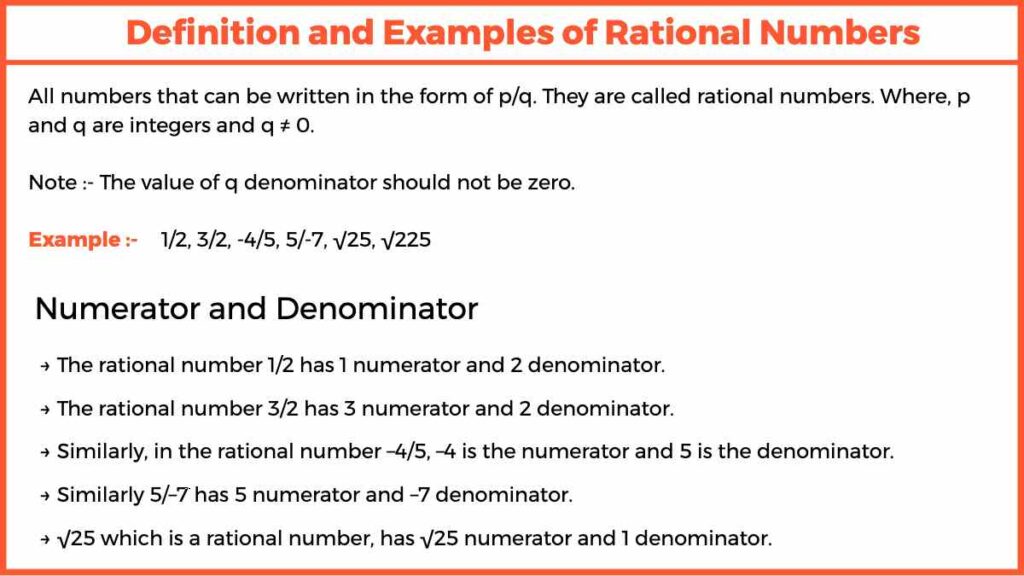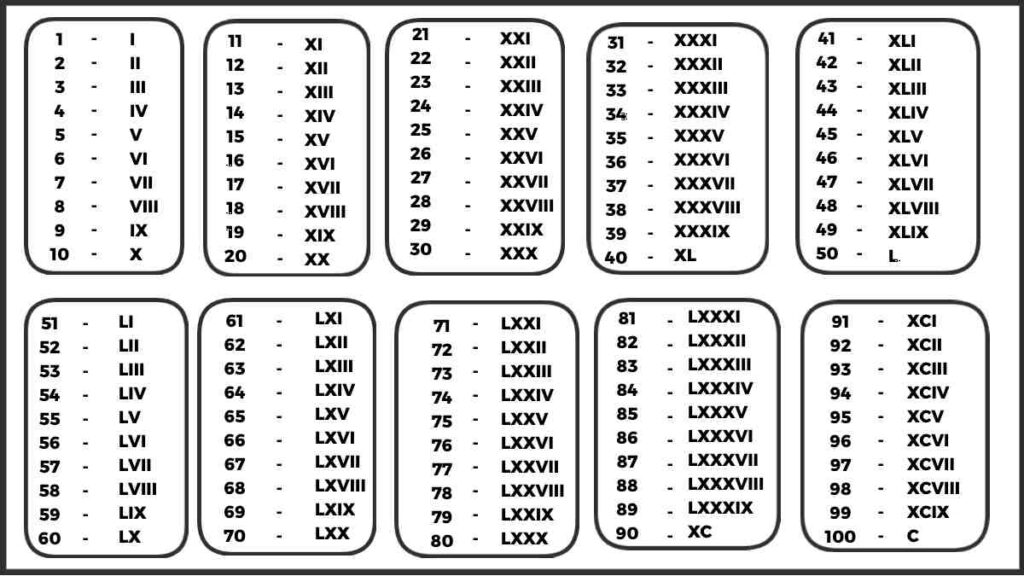If you want to know about Rational Numbers on this page, then definitely read this post completely.
On the previous page, I have shared the information about Composite Number and Prime Number, read that article also.
Let us read and understand the information of Rational Number today.
What are Rational Numbers
All numbers that can be written in the form of p/q. They are called rational number. Where, p and q are integers and q ≠ 0.
Note: The value of q denominator should not be zero.
Example :- 1/2, 3/2, -4/5, 5/-7, √25, √225
Numerator and Denominator
A rational number is of the form p/q, in p/q p is called the numerator and q is called the denominator.
→ The rational number 1/2 has 1 numerator and 2 denominator.
→ The rational number 3/2 has 3 numerator and 2 denominator.
→ Similarly, in the rational number –4/5, –4 is the numerator and 5 is the denominator.
→ Similarly 5/–7 has 5 numerator and –7 denominator.
→ √25 which is a rational number, has √25 numerator and 1 denominator.
Read the post of Ansh and Denominator for more details.
Note :-
If numbers with a decimal fraction are counting the numbers after the decimal or repeating the numbers after the decimal. So such number are called rational number.
For example :- 1, 2, 3, 1/2, 2/5
Difference between positive rational and negative rational number
Rational number are of the form p/q, where both p/q are integers. (q or denominator) is not always equal to zero. There rational number can be positive and negative.
Number are positive rational if and only if (+p/+q) are negative rational number if and only if -(p/q).
| Positive Rational Number | Negative Rational Number |
|---|---|
| Rational numbers in which both numerator and denominator are positive are called positive rational numbers. | Rational numbers whose numerator or denominator is a negative number are called negative rational numbers. |
| The numerator and denominator both have the same sign. That means (p/q) or (+p/+q) will be positive rational numbers. | If both numerator and denominator are of opposite sign, i.e. -(p/q) = (-p)/q = p/(-q), then they are called negative rational numbers. |
| Positive rational numbers are greater than zero. | Negative rational numbers are smaller than zero. |
| Examples of positive rational numbers :- 2/3, 4/5, 5/6, 6/7, 2.1 | Examples of positive rational numbers :- 2/-3, 5/-7, -6/7, – 2.1 |
Equivalent Rational Number
Such rational number which are equal to each other are called rational number equivalent to each other.
Finding equivalent rational number for given rational number
Multiplying the numerator and denominator of a rational number by the same non-zero integer gives another rational number equal to or equal to the given rational number.
Example :-
Multiplying 2 in the numerator and denominator of 3/4 will result in rational number equivalent to 3/4.
3/4 = (3 × 2)/(4 × 2)
3/4 = 6/8
So 3/4 is equivalent to 6/8 rational number.
Similarly 3/4 = (3 × 3)/(4 × 3)
3/4 = 9/12
So 3/4 is equivalent to 9/12 rational number.
Similarly 3/4 = (3 × 4)/(4 × 4)
3/4 = 12/16
So 3/4 is equivalent to 12/16 rational number.
So 3/4, 6/8, 9/12 and 12/16 are equivalent rational number because they are equal to each other.
Questions and Answers Related to Rational Number
Question 1. Is zero (0) a positive rational number or a negative rational number?
Answer :- Zero (0) is neither a positive rational number nor a negative rational number.
Question 2. Compare 1/2 and 1/3?
Solution:- According to the question,
1/2 and 1/3
The least common factor of the denominators 2 and 3 of these two rational number is 3 × 2 = 6
Thus, 1/2 = (1 × 3)/(2 × 3) = 3/6
And, 1/3 = (1 × 2)/(3 × 2) = 2/6
Now since 6 is greater in the numerator of 3/6 and 2/6, therefore
3/6 > 2/6
or, 1/2 > 1/3
That is, 1/2 is greater than 1/3.
Answer :- 1/2 > 1/3
Question 3. Compare -2/3 and 3/4?
Solution :- According to the question,
A negative number is smaller than a positive number.
Among the given rational number -2/3 and 3/4 -2/3 are negative rational number.
So -2/3 is smaller than 3/4
or -2/3 < 3/4
Answer: -2/3 < 3/4
Question 4. Compare the rational number 3/5 and 6/7?
Solution:- According to the question,
Given rational number 3/5 and 6/7
on thunder multiplication
thunder multiplication
3 × 7 and 6 × 5
21 and 30
21 < 30
So 3/5 < 6/7
That is, 3/5 is less than 6/7
Answer:- 3/5 < 6/7
Question 5. Find 3 rational number between the rational number 3 and 5?
Solution:- According to the question,
Given rational number are 3 and 5
Step 1. Write these given numbers in the form of p/q
3 = 3/1 and 5 = 5/1
Step 2. Add 1 to the number of rational number between the given number.
Since 3 rational number are to be found among the given rational number, thus 3+1 = 4
Step 3. Multiply the numerator and denominator of the given rational numbers by 4.
3/1 = (3 × 4)/(1 × 4) = 12/4
and 5/1 = (5 × 4)/(1 × 4) = 20/4
Step 4. Now find three rational numbers between the rational numbers obtained.
Clearly, there are rational numbers between 12/4 and 20/4.
12/4 and 20/4
Answer :- 13/4, 14/4, 15/4, 16/4, 17/4, 18/4 and 19/4
FAQ
Ans. A rational number, in Mathematics, can be defined as any number which can be represented in the form of p/q where q ≠ 0.
Ans. A rational number is the one which can be represented in the form of P/Q where P and Q are integers and Q ≠ 0. But an irrational number cannot be written in the form of simple fractions.
Ans. Square Root of 2 is an Irrational Number, i.e. it cannot be given as the ratio of two integers.
Ans. Rational numbers include perfect squares such as 4, 9, 16, 25, and so on. Irrational numbers include surds such as √2, √3, √5, √7 and so on.
| Read More : | ||
| Natural Numbers | Even Numbers | Odd Numbers |
| Whole Number | Integer Number | Prime Numbers |
| Irrational Numbers | Real Numbers | Unreal Numbers |
Hope you liked the information about Rational numbers.
If you want to ask any question related to rational numbers then you can ask in the comment section.


